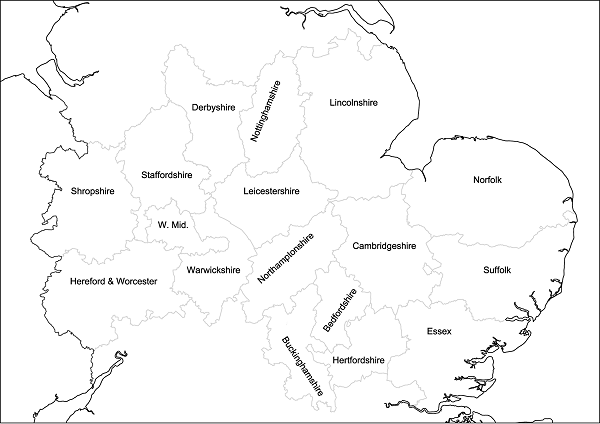A Review of Animal Bone Evidence from Central England
Umberto Albarella, Tessa Pirnie, 2008. https://doi.org/10.5284/1000317. How to cite using this DOI
Data copyright © Umberto Albarella unless otherwise stated
This work is licensed under the ADS Terms of Use and Access.
Primary contact
Umberto
Albarella
Department of Archaeology
University of Sheffield, Department of Archaeology
Minalloy House
10-16 Regent Street
Sheffield
S1 3NJ
United Kingdom
Tel: 0114 22 22943
Resource identifiers
- ADS Collection: 768
- DOI:https://doi.org/10.5284/1000317
- How to cite using this DOI
Introduction
The principal aim of this project, funded by English Heritage, was to produce a review of the animal bone evidence from Central England from Mesolithic to modern times. The dataset collected for this purpose consisted of details gleaned from excavation reports (or specialist bone reports), concerning vertebrate remains (of fishes, amphibians, reptiles, birds and mammals) found primarily on archaeological sites. As well as the production of this Regional Review, the intention was to make the dataset freely available and searchable online, and it is this latter resource which is presented here.
The Regional Review report accompanying the database is published in the Historic England report series:
Albarella, U, 2019 Review of Animal Bone Evidence from Central England. Research Report Series 61/2019. Portsmouth: Historic England.
Geographical scope
The geographical region of 'Central England' is defined here as those areas generally known as West Midlands, East Midlands and East Anglia. Therefore, the following counties are represented: Bedfordshire, Buckinghamshire, Cambridgeshire, Derbyshire, Essex, Hereford and Worcester (now the separate counties of Herefordshire and Worcestershire), Hertfordshire, Leicestershire, Lincolnshire, Northamptonshire, Norfolk, Nottinghamshire, Shropshire, Staffordshire, Suffolk, Warwickshire and the West Midlands.

Criteria for inclusion
Reports were included on the criteria that they were analytical reports of archaeological sites (or syntheses), with reasonably securely dated phasing, even where dating was broad. Non-anthropogenic sites were included only when they contained information of direct relevance to archaeological questions.
Assessment reports and evaluations were excluded with few exceptions, for which the information was in any case recorded selectively. While the bulk of the literature was from published sources, reports that were widely available for distribution, such as those from the Ancient Monuments Laboratory/Centre for Archaeology (English Heritage), were included, as were selected unpublished and 'forthcoming' manuscripts.
No lower limit was applied to the size of an assemblage, on the basis that even a single bone may potentially provide useful information. However, small assemblages that provided no reliable quantitative information and supplied little more than a list of taxa commonly found at contemporary sites were excluded.
Contents of the dataset
The details selected for entry into the database include the full bibliographic reference, summary descriptions of each site (for instance, its type, location and dating) and of the bone assemblages recovered. Quantitative information (such as the number of identified bone fragments for each species) is reproduced from the site reports. Other descriptive or interpretative information (such as the type of butchery patterns noted, or the age-profile of a certain animal) is presented in summary form. For further information about the dataset and how to query it, see Overview.






